We sat through sundry fashion shows at the just-ended fashion week in Mumbai and just as we’d begin to feel uninspired, there came along clothes makers who’d rescue us from resignation

Shivam Dubey in a design by Rajesh Pratap Singh; Lakme brand ambassador Mrunal Thakur in a Rajesh Pratap Singh ensemble; Adarsh wears a Rajesh Pratap Singh look, styled with ghungroos on boots. Pics/Shadab Khan
 Of course, nearly all fashion brands revel in the design process as a creative mix of instinct, necessity, marketing and merchandising. A practice that imagines clothes through the lens of a muse, context and technique now seems tailor-made exclusively for maximum influence on social media and little else.
Of course, nearly all fashion brands revel in the design process as a creative mix of instinct, necessity, marketing and merchandising. A practice that imagines clothes through the lens of a muse, context and technique now seems tailor-made exclusively for maximum influence on social media and little else.
ADVERTISEMENT
The show is the moment the clothes connect with people. But when the clothes lack points of view, how can they engage with the wearer? Those are the overarching sensibilities we assimilated after carefully considering the “fashion” presented at the just-concluded FDCI x Lakmé Fashion Week.
The clothes may have been well-made (a few designers easily ticked the aspiration box), but it’s not often that we appreciated a collection for presenting content with commerce, technical brilliance, critical design thinking or in lieu of having a pulse on identity politics. Very few designers harvested notes from the brand’s heritage or pushed boundaries as shapeshifters, or bothered to give us clothes expressing an emotion or narrative.
But like with life, at fashion week too, all is not lost. When everything is available 24/7, and we are inundated with information in every style, shape and form, we are calling time on overcrowding and window display of “lewks”, to single out (in a good way) those who continue to inspire.
Rajesh Pratap Singh
So many moods, so many incarnations… Rajesh Pratap Singh’s curtain-closer show for Lakmé Fashion Week held in partnership with FDCI asserted the eternal allure of the classic “Pratap white shirt” in every avatar; dinner and tuxedo, peplum and pleats.
His interpretation of clothing styles from the 1950s felt self-consciously retrospective (without being burdened by direct references); harking back to the time when India was young and resolute as a newly independent nation. Flower Duet, the first act of Leo Delibes’s Lakmé (a French rendering of Lakshmi, the Goddess of wealth) performed by singers of the Neemrana Music Foundation, offered an emotional purge.
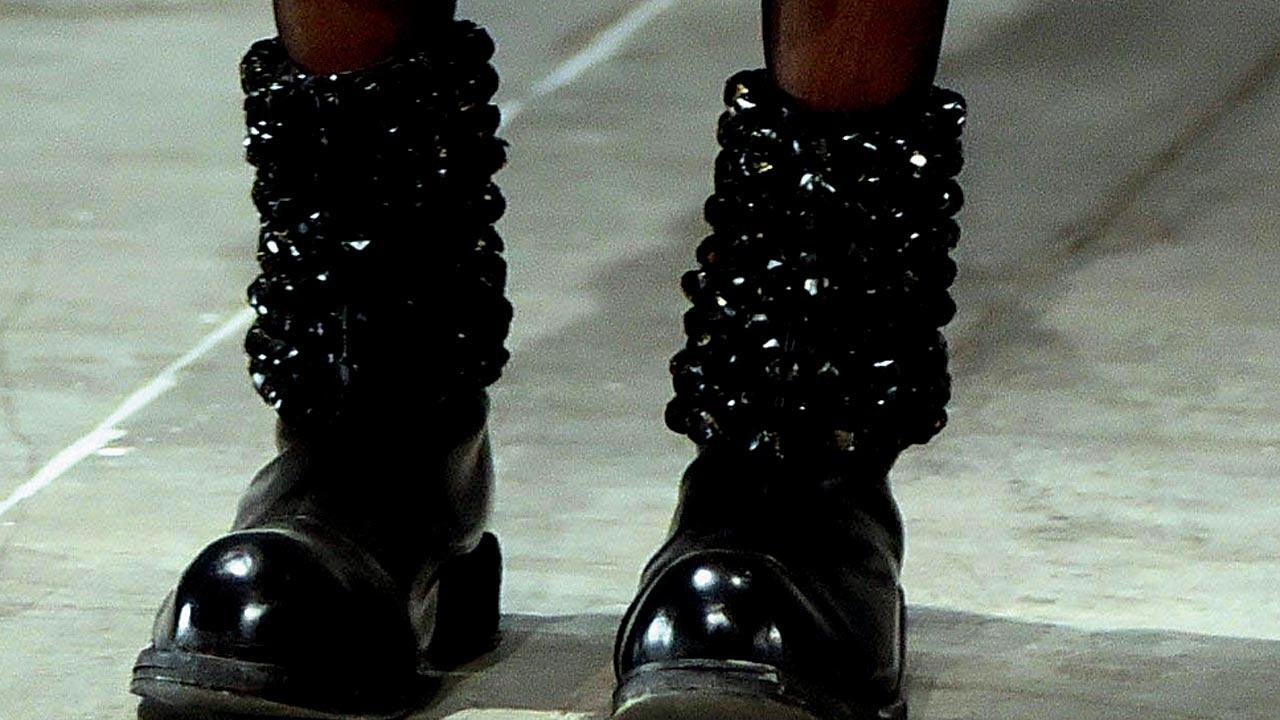
Meanwhile, in a wistful throwback to mannered elegance, the erstwhile salon styles of the ’50s—cinched waists and balloon hemlines, cocoon and opera coat styles in dropped shoulder seams, statement sleeves and sharp tailoring, and finally issuing the cult of sarees—took stage in the virtuoso display. This chapter in history also speaks powerfully about homegrown beauty brand, Lakmé’s leading lady Simone Tata, the defining icon of modern elegance and of signature pearl necklace in the 1950s.
RPS is a cerebral and controlled clothes maker, with an unusual gift for making the complex seem simple while stating the obvious, but oh so cleverly. Because what’s more obvious than a black and white pairing, which he presented in a modern dance of long dress hybrid (a blend of a wide-peaked lapel, double-breasted sleeveless blouse and a draped skirt), short dresses, shorter jackets with immaculate cuffs and ghungroo-stacked boots styling detail.
Gaurav Gupta
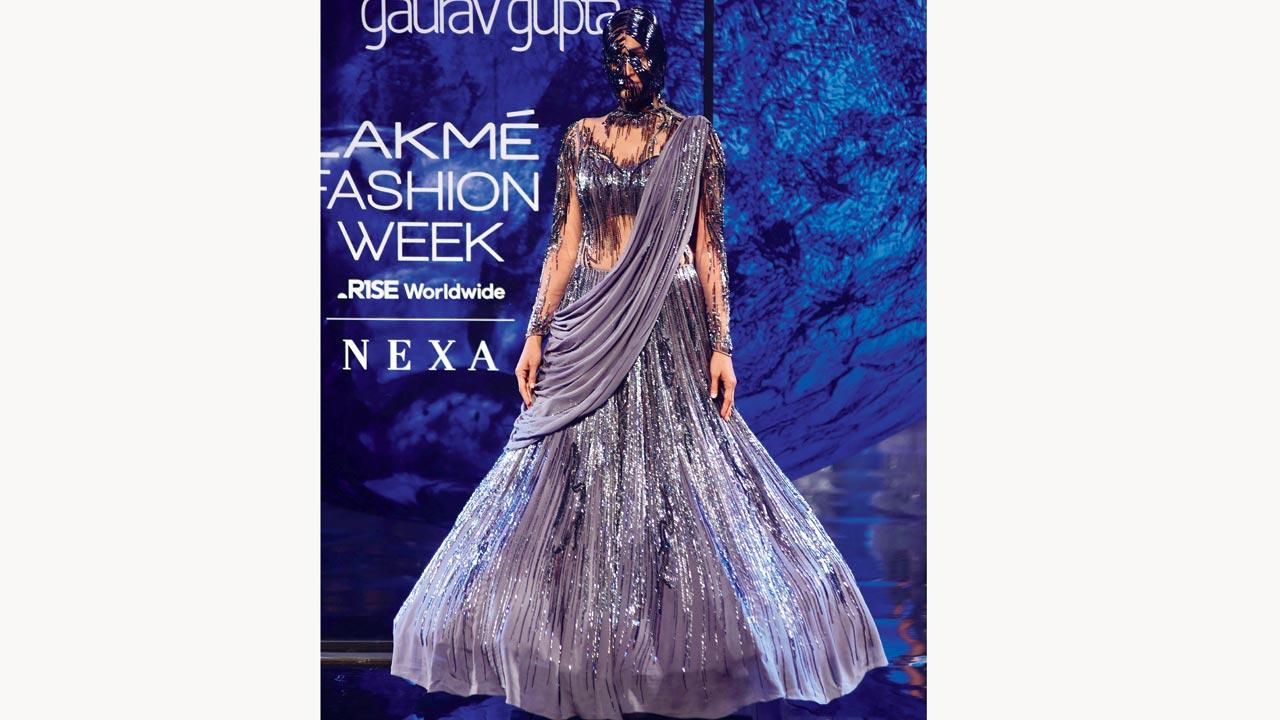 Rachel Bayros in a Gaurav Gupta ensemble
Rachel Bayros in a Gaurav Gupta ensemble
Despite the theme and set design that screamed “Instagram me”, the clothing ideas by Gaurav Gupta came across as well-thought-out. He knows how to make Indian costume traditions live, by playing with materials and techniques and giving them a voice of today. The designer revisited the lehenga-choli pair and presented what his brand is now synonymous with: a one-piece gown comprising a georgette skirt attached to the tulle bodice and dupatta. “The idea is to celebrate goth, futuristic elements in modern Indian couture which is essentially the saree and the lehenga-choli,” Gupta explains.
We suspect that Gupta foraged through a hundred shades of grey before he found his “galactic lava grey” for the gown, while his knowledge of fabric manipulation and dressmaking allowed him to infuse a hard-to-copy sculptural quality in his clothes. The use of 3-D glass bugle beads and sequin embroidery seemed to mimic meteor showers sprayed on the wearer of his ensemble, with a hint of art nouveau-inspired gilded threadwork strewn on the blouse. The mask, as a styling detail, not only interpolated imagined galaxies but also made the best case for a gender-blurring future.
Abraham & Thakore
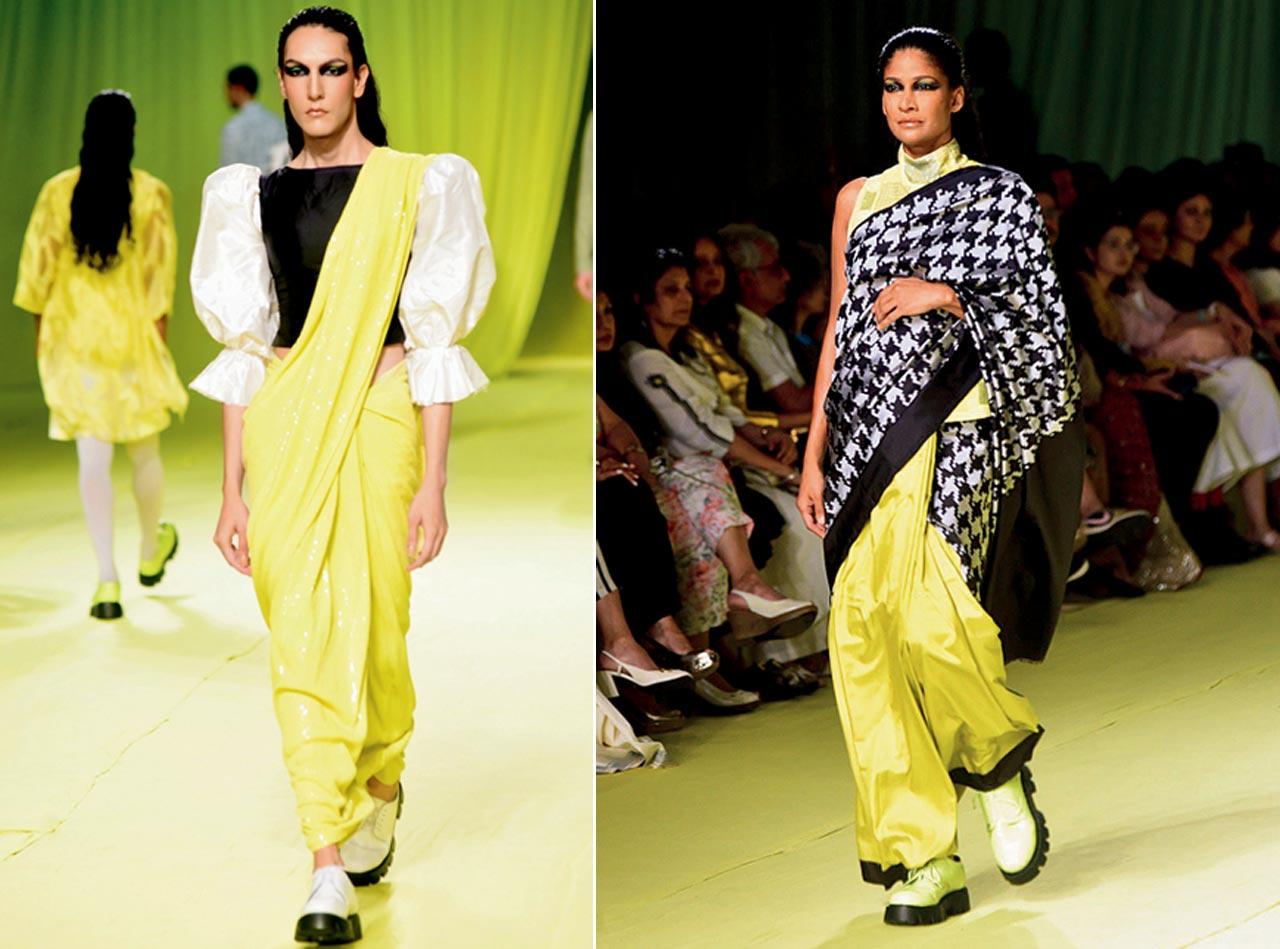 Gaia Kaur in an Abraham & Thakore ensemble; (right) Carol Gracias wears Abraham & Thakore’s black and white houndstooth patterned, double ikat saree
Gaia Kaur in an Abraham & Thakore ensemble; (right) Carol Gracias wears Abraham & Thakore’s black and white houndstooth patterned, double ikat saree
If you accept that fashion reflects the times—and this writer does—then you have to concede that the Abraham & Thakore show that celebrated three decades of the brand, was impressive, even prescient. The collection caught the mood, thoughts and values of the present. The triumph of logo rebranding. The need for simple messaging on social media: “…for all the days you’re not getting married”. The return of the black and white houndstooth pattern on a handwoven double ikat silk saree, first modelled by Carol Gracias at their debut show at the 2010 Delhi fashion week. (The saree with a matching shirt ensemble is part of permanent archives at London’s Victoria & Albert Museum.)
This was not, however, a trip down memory lane, but a fresh look at the brand’s past hits, reigniting the reciprocal affair they continue to enjoy. Teamed with towering Oxford shoes, the saree was once again draped by Gracias but this time with a high-neck sleeveless blouse. What could only be interpreted by this writer as a hat tip to the original design idea, Gaia Kaur’s ensemble at the show was reconceptualised with the colour palette of chartreuse (yellow), black and white, without the houndstooth pattern. The Victorian puff-sleeve blouse replaced the formal shirt from the original; the saree winked and smiled in pearlescent sequins. It was as clear and canny a message as any about A&T knowing how women want to look.
Anand Kabra
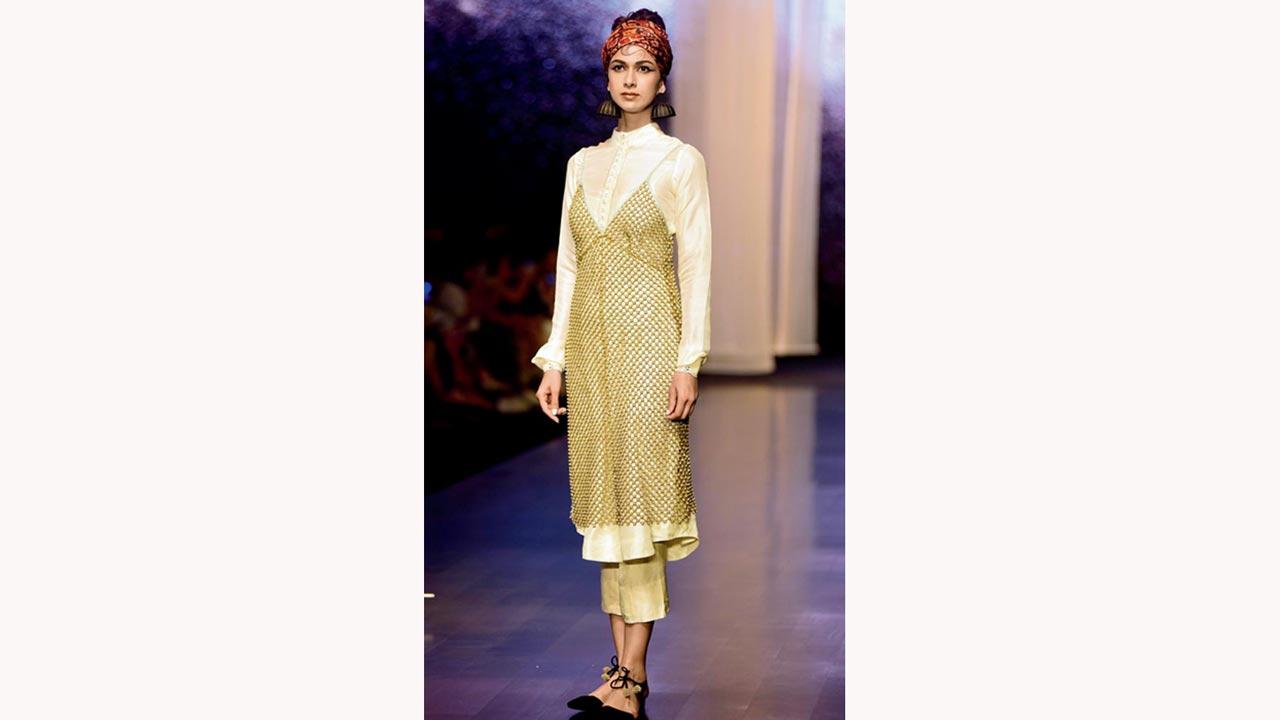 Reha Sukheja in an Anand Kabra ensemble
Reha Sukheja in an Anand Kabra ensemble
Anand Kabra’s refusal to scramble to achieve a “position” in an industry that once feted him, is refreshing. Five people worked on a metallic thread and pearl embroidery slip dress over seven days. Kabra first designed the pattern, which was transferred to a khaka, traced and handed over for embroidery. “We had one person solely assigned to burn holes with agarbatti (incense sticks) and get rid of the negative spaces to create effective results,” Kabra says about the process.
This piece brings to mind the jali wall and minarets on the facades of Hyderabad’s Toli Masjid (1671 AD) in cutwork and delicacy. “It is craft, it is handmade, it is ultimate couture. You can layer this piece over a kurta, shirt or a dress, and if you are daring, wear it sheer with lingerie. Separates is where I see the future of Indian fashion. Let’s celebrate individuality.”
Nachiket Barve
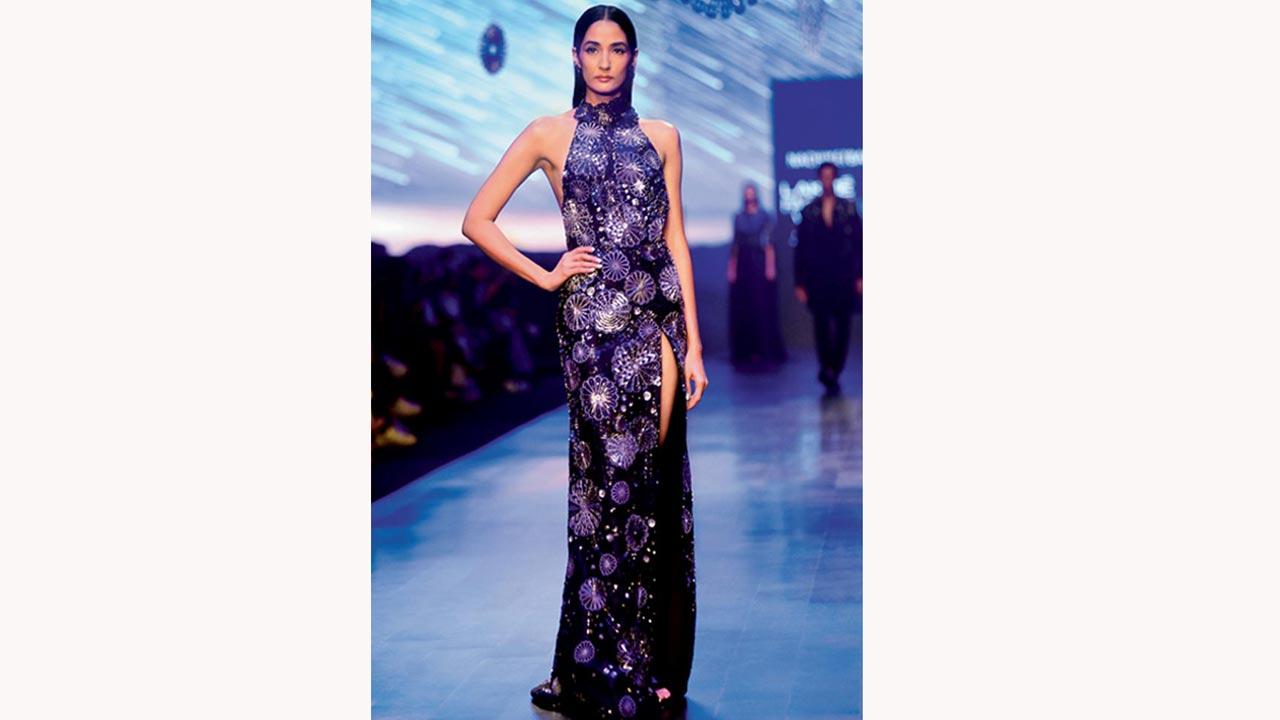 Daman Brar in an ensemble by Nachiket Barve
Daman Brar in an ensemble by Nachiket Barve
Straight up representation, Nachiket Barve argues, is a bit banal. “The abstract version of a flower or maybe an anemone, or even a stylised constellation is exciting for me,” Barve says of what’s become the brand’s signature motif. Once perceived as a feminine cliché, Barve’s interpretation brings to mind the Baroque round mandala pattern (a circular figure representing the universe in Hindu and Buddhist symbolism).
This long dress made from 21 meters of handwoven silk organza took 1,284 hours of intricate, eye-straining handwork to create the cutwork, applique, beading and thread embroidery. And yet, it weighs only 280 grams. “This piece amalgamates the effortless minimal luxury that I have always strived to express. I’ve learned over the years to get out of my head and carefully look at the women I dress and consider what they want. In a way that feels authentic and uncompromising to me.”
Bloni by Akshat Bansal
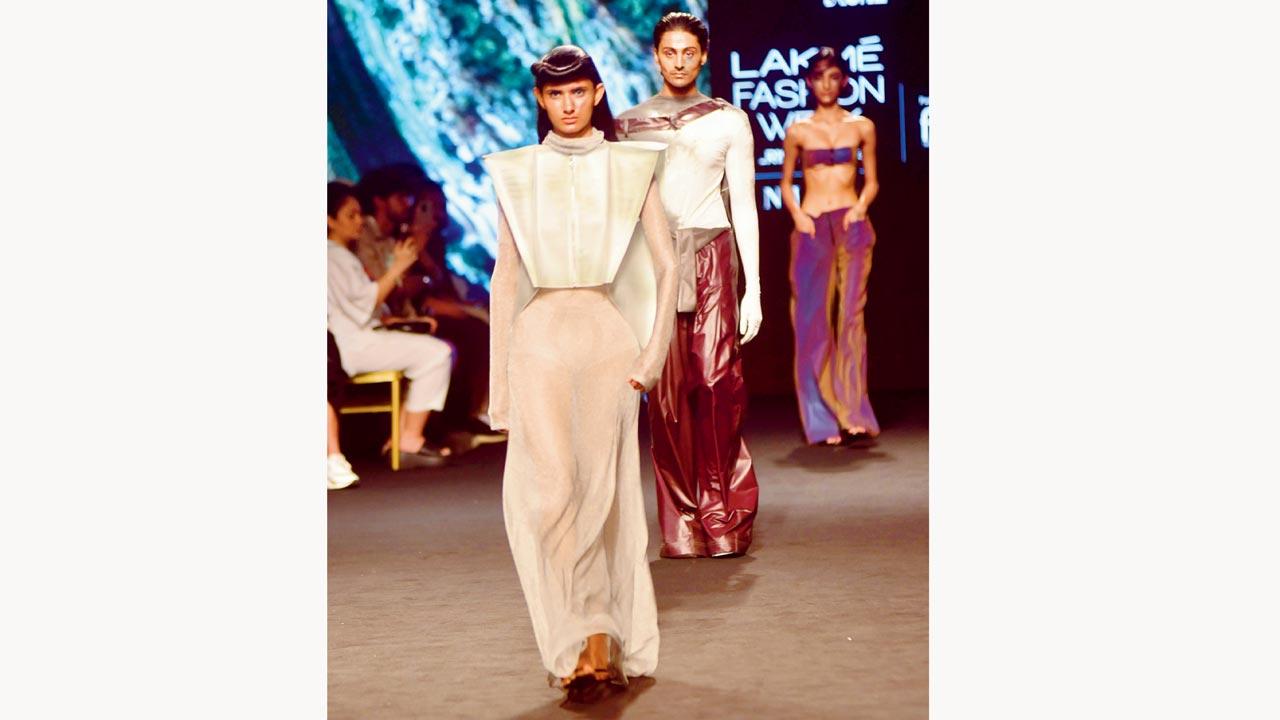 Vanshika Saxena in a Bloni ensemble
Vanshika Saxena in a Bloni ensemble
The crazier the world gets, the more Akshat Bansal’s supersized clothing ideas make sense. By contrast to the usual lineup of look-at-me-baby (insert jazz hands here), the harnesses, the skin and dystopia-core finery at the Bloni show didn’t exactly scream “wear me”. His clothes carry an overall approach of dealing with the body, its pleasure and power. And the ways in which it can be fetishized, co-opted and curbed suggests that this young designer understands the direction in which things are whizzing about ahead.
He calls the show, “the first instinctive frontline of experiencing reconstructed emotions revealed via stories and truths in the future”. His appropriation of emotions as single-mindedly gender agnostic come undone with the play of proportions in the form of cropped jackets with exaggerated shoulders, sliced jumpsuits, and a line of low-waist, cavernous jeans with its zips and fastenings relocated to the side panel; bye-bye saggy crotch.
The future is key for Bansal. The austere medieval-style pewter gown is crafted from recycling stainless steel metal waste, converted into yarn of soft metal; on sight and touch, it looks and feels no different than any luxe fabric. Bansal pairs this ensemble with a sculpted boxy jacket with jagged power shoulders, created entirely from rubber.
 Subscribe today by clicking the link and stay updated with the latest news!" Click here!
Subscribe today by clicking the link and stay updated with the latest news!" Click here!







